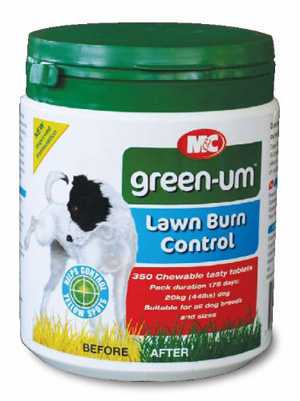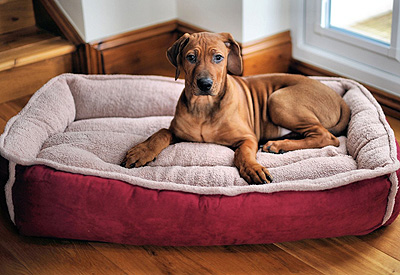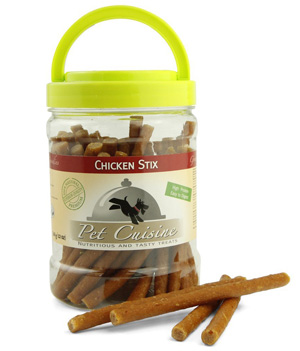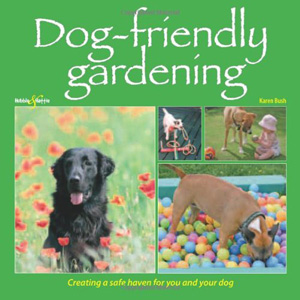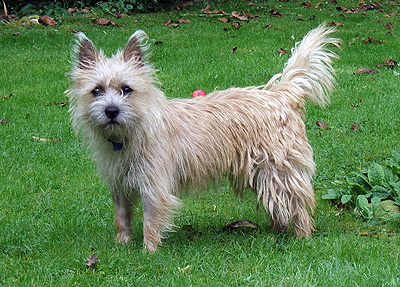
Dogs and Gardens
Having the lovely garden you want and a lovely dog/s are not always two compatible aims unless you make some compromises along the way.
There are no simple answers unfortunately and no magical products that will provide a quick fix. It is possible to have both a dog and a garden and to be proud of each of them. It just might take a little time to get there, here's some help along the way.
The approach is one of a combination of damage limitation and training the dog, you may also have to just accept that there are certain things you can't have in your garden along with the dog. Younger dogs are more damaging than older dogs, so part of the answer is that things will get better in time as the dog grows up.
Dogs and Lawns
The number one question, usually goes something like "My dog has destroyed my lawn and now I want to repair it, but I also want to keep the dog and let it have some exercise".
Dogs (especially large dogs and multiple dogs) and lawns (especially small lawns) just don't go that well together. I have a small dog and a large lawn as I now write in mid-March after a winter of virtually no grass growth, there's a definite path down one side of the lawn where my dog goes on her regular rounds. It's not down to the soil though and in the spring when I start mowing and the grass starts to grow again, the path will all but disappear. It could easily become a permanent muddy path if the garden was a little smaller and the dog a little bigger.
Once an area has become muddy, then getting back to grass again is particularly difficult.
Solutions?
- If starting a lawn from scratch or renovating a muddy area, go for turf rather than seed, it will be walkable sooner. Keep the dog/s off the area for at least a month (2 or 3 is better). If you must use grass seed, then try to keep the dogs off the seeded area for at least 3 months for it to start to establish. You can often buy turf in small quantities from garden centers or DIY stores. Protect the repaired area with a fence of canes and chicken wire until established.
- Use hard surfaces wherever practicable, especially near the house. A patio will protect the most highly trafficked region where the dog/s go out. Paving slabs set into the lawn beyond this in the next most worn regions will help protect these too.
- Instead of reseeding Rover's favourite pathway, why not place stepping stones in it first to reduce wear or even just turn it into a proper path?
- Artificial turf - this has come on a long way in recent years and doesn't look as artificial as it used to by a long way, there are also many different grades for differing requirements. The surface is porous so liquids pass through it, you just have to make sure you poop-scoop regularly. The downsides are that it is a lot more expensive to lay than a lawn needing a sub-base in the way that a patio does with the "grass" then being laid, pegged and held in place with sand. As a rule of thumb it will cost about the same as having a patio laid, in the region of £50-£70 per square meter. If comparing prices, be aware that many of them are for the artificial grass covering only and not inclusive of the materials for the sub-base or of the labour required to prepare and lay it. It has an expected life of around 15-20 years with 5-10 year guarantees being typical. The surface will fade with time as plastic does in sunlight, though when it needs replacing, the sub-base will already be in place so it won't be quite so expensive as when it was first laid.
- Gravel / Bark Chippings - What a wonderful medium to dig through to get at the soil underneath! Also no fun separating dog poo from lots of little bits that stick to it - yuck!
Bitches and urine spots
This is a fairly common problem with female dogs of large breeds. Bitches tend to deposit all of their urine in one place which can result in die-back of the grass in that area. It's not such a problem with males as they spread it around a lot more and the smaller quantities in any one place are less of a problem.
There is no simple solution and water is the best way of neutralizing the urine. The real problem is being around when the dog urinates and seeing where she has done it, if you can do this, then keep a hose handy and spray the area, alternatively a bucket of water will do the same job.
Long term, you could try keeping an area as the "dog toilet", say put bark chips down and try to train your dog to use that area, though this is not as easy with dogs as with cats who take to a specific toilet area better.
This tends to be a summer problem as in the winter, the soil and grass are often already wet, so the urine is more diluted. You can repair damaged areas by replacing the top layer of soil, 1-2" and re-seeding or replace with new turf.
Received by email
1. Just read a question
from a lady who says her Labrador bitch is killing her lawn.
We have the same problem and came across a product called
'Green-um'. They are tablets you give your dog in
their food once a day. Works brilliantly!
from
Carole Mattinson:
2. Re dog urine and grass die back, A dollop of tomato ketchup in the food once a day works wonders....and the dogs love it too!
Dogs and Plants
Dog proof plants? - it's usually a question of scale, large plants are more dog-proof than smaller plants for obvious reasons. Some dogs just take a liking to digging up plants I once had a black Labrador that really liked to dig out large intact grass plants from the lawn - very frustrating. This is a question of training more than anything, and most dogs will grow out of the habit, it may be a sign of boredom or frustration and maybe the dog needs more exercise than it gets from being enclosed alone in a small garden.
Generally thorns and plants with scented leaves will be avoided, so, Holly, Pyracantha, Berberis, Rosemary, Lavender etc. are safe bets. A low growing lavender hedge could even be used to protect flower beds beyond it (though I've never tried).
Low fences and edging are a great way of training a dog to stay off areas where you don't want them - flower beds in particular. Of course the dog won't know this to start with and will need to be trained so that they know to stay on the grass or patio side of the barrier and are not allowed onto the soil side. These are available in a whole variety of materials and designs from about 4 to 8 inches in height. When my vegetable garden is more or less bare in the winter I use long pieces of wood held about 6-8" above the ground with 12" long pegs I knock into the soil like a giant elongated staple which work well to keep our now fairly well trained dog off it. Such barriers can be removed when the dog is used to them and avoids the area.
Raised beds can be a good way of protecting particular plants such as herbs from dogs and their bodily fluids. A bed of 2-3 railway sleepers depth or made of brick and filled with topsoil is a good way of keeping your plants safe. They also make good design features and bring aromatic plants in particular closer to our level for ease of sniffing, cultivation and gathering.
Protect new plants - newly planted specimens are more interesting than older mature ones and newly disturbed earth hugely more fascinating. If your dog like to dig up newly planted introductions then try protecting them for a few weeks until the soil has settled and they are not so novel. Wooden boxes or planks pegged in place or chicken wire and cane barriers won't look pretty in the garden, but they will only be temporary arrangements and the chances are your plants will be safer when you take them away.
Q. We have 4 dogs but we also like to grow herbs etc. At the moment we have the herb collection in pots, either perched precariously on bricks to keep them above dog leg height, or on a bench. As our collection grows this is becoming less practical. Short of banishing the dogs from the garden, can you suggest a practical, economical and hopefully attractive way to keep a large herb collection safe from canine contamination?
A. The best bet I think would be to build a raised bed. You can do this easily by using railway sleepers, a low brick wall or thick marine ply held in place with stout stakes. About 18" high would probably be adequate, and the herbs will like the extra drainage provided by the raised bed. You would probably like the fact that you will need to water less than you do in pots as the soil volume is much bigger.
Copyright 2000 - present. All Rights Reserved | Privacy Policy Statement

